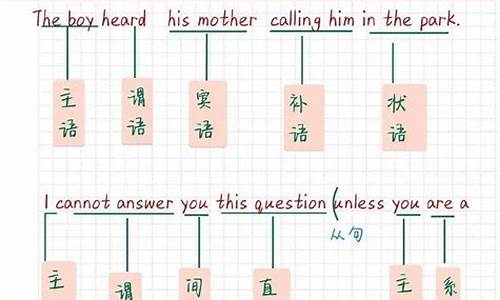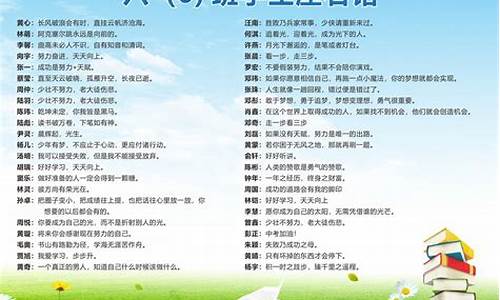您现在的位置是: 首页 > 经典语录 经典语录
_句子成分用英语怎么说单词怎么读
tamoadmin 2024-09-05 人已围观
简介1.英语句子成份一共有哪些?2.划分下句子成分啊In no case will I lose heart.3.英语句子成分是什么?4.求分析英语句子成分5.英语句子成分问题6.分析英语句子成分句子的成分: 构成句子的基本成分叫做句子成分。句子成分可分为主语,谓语,宾语,表语,定语,状语,同位语。它们可以由单词来担任,也可以由词组,以及句子来担任。 句子是阅读理解和听力理解的最基本的单位。主语:是一
1.英语句子成份一共有哪些?
2.划分下句子成分啊In no case will I lose heart.
3.英语句子成分是什么?
4.求分析英语句子成分
5.英语句子成分问题
6.分析英语句子成分

句子的成分: 构成句子的基本成分叫做句子成分。句子成分可分为主语,谓语,宾语,表语,定语,状语,同位语。它们可以由单词来担任,也可以由词组,以及句子来担任。 句子是阅读理解和听力理解的最基本的单位。
主语:是一个句子中所要表达,描述的人或物,是句子的主体。主语可以由名词、代词、数词、不定式、动名词、分词、主语从句和短语等来担任。
Two and two are/is four.二加二等于四。
Smoking is bad to health. =吸烟对身体有害。
The wounded has been taken to the hospital.伤员已经送到医院。
When to begin is not known yet.什么时间开始还不知道。
What I know is important.我所知道的很重要。
谓语:是用来说明主语做了什么动作或处在什么状态(系表结构)。谓语可以由动词来担任,一般放在主语的后面。
We don't know him very well.我们不太了解他。
She speaks English fluently.她英语讲得很流利。
Betty stayed awake at night on purpose.
表语:是用来说明主语的性质, 身份, 特征和状态。表语须和连系动词一起构成句子的复合谓语。表语一般放在系动词之后。表语可以由名词, 形容词或起名词和形容词作用的词和短语或者表语从句来担任。
I am all right.我没事。 It's over.时间到了。 She is ten.她十岁了。
My work is teaching English.我的工作是教英语。
The dictionary is in the bag.词典在书包里边。
My question is how you knew him.我的问题是你如何认识他的。
宾语:是谓语动作所涉及的对象, 它是动作的承受者,宾语可以由名词或起名词作用的成分担任,宾语一般放在及物动词或介词之后。
I saw a cat in the tree.看见树上有一只猫。I want to go shopping.
He said that he could be here. 他说他会来的。
I’m concerned about my friend’s safety.
有些及物动词可以有两个宾语,即双宾语 ,其中一个宾语多指人,另一个宾语指物,指人的宾语叫做间接宾语,指物的宾语叫做直接宾语, 可以带两个宾语的动词有 offer, bring, give , show, send, pass, tell, lend, 等。间接宾语一般放在直接宾语的前面,如果强调直接宾语可把直接宾语放在间接宾语的前面,但间接宾语前须加 " to "。
My father bought me a book.我父亲给我买了一本书。
Give the rubber to me.把橡皮给我。
有些及物动词除跟一个宾语外,还需要加上宾语补足语,否则意思不完整, 它们一起构成复合宾语,复合宾语中宾语和后面的宾语补足语有一种逻辑上的主谓关系,是判断是两个宾语还是复合宾语的依据, 宾语可以由名词或起名词作用的词担任。
We all call him Lao Wang.我们都叫他老王。
Please color it red.请给它涂上红颜色。
定语:用于描述名词,代词,短语或定语从句的性质,特征范围等情况的词叫做定语, 定语可以由名词,形容词和起名词和形容词作用的词,短语担任。如果定语是单个词,定语放在被修饰词的前面,如果是词组或短语,定语要放在被修饰词的后面。
That is a beautiful flower.那是一朵漂亮的花。
The TV set made in that factory is very good.
This is my book, not your book.这是我的书,不是你的书。
I he a lot of things to do.我有好多要做的事情。
Our country is a developing country.我们的国家是一个发展中的国家。
状语: 说明事物发生的时间,地点,原因,目的,结果、方式, 条件或伴随情况,程度等情况的词叫状语。状语可以由副词、分词、短语及状语从句来担任。
We went to the countryside last year.去年我们去了乡下。
We study hard for our country.我们为我们的国家而努力学习。
I'm late because I missed the bus.由于误了车,所以我迟到了。
简 单 句
简单句可分为下列五种形式:
1) 主语 + 系动词 + 表语。 I am a student.我是一名学生。
2) 主语 + 不及物动词+状语。
The sun rises in the east.太阳从东方升起。 。
3) 主语 + 及物动词 + 宾语
We help each other.我们互相帮忙。
4) 主语 + 及物动词 + 间接宾语 + 直接宾语
I ge him a book last week.上周我给了他一本书。
5) 主语 + 及物动词 + 宾语 + 宾语补足语.
I heard him singing in the hall.我听见他在大厅里唱歌。
并 列 句
并列句: 用并列连接词把两个或两个以上的简单句连接在一起的句子叫并列句.常用的连接词如下: also, and, but, either ... or, however, not only...but also, or, or else, so, still, yet, neither...nor.
并列句的构成: 简单句 + 连接词 + 简单句。
He studied hard and he passed the examination.
Let's hurry, or we'll be late.咱们赶紧点,要不就迟到啦。
I he been to Beijing many times but my parents he never been there.
复 合 句
复合句是由两个或两个以上的有主谓结构的句子用从属连词连接起来的句子。其中一个句子是主体,叫做主句,而其他的句子叫做从句。
从句由连接词引导, 它们是: that, before, whether, if, although, because, as long as, as soon as, since, after, who, which, whom, what, whose, why, where, how, when 。
从句尽管有主谓结构,但不能单独成为一个句子,在句中, 从句仅担任某个成分,根据担任的成分从句可分主语从句,宾语从句,表语从句,定语从句,状语从句。
主语从句:在句中起主语作用的句子叫做主语从句. 主语从句一般放在句首。引导主语从句的词有下列: that, who, whether, if, what, which, when, where, how, why.
Who cleaned the blackboard is not known yet.谁擦的黑板还不知道。
It's very good that he has passed the exam.他通过了考试太好了。
宾语从句:在句中起宾语作用的句子叫做宾语从句,宾语从句放在动词后面。引导宾语从句的词有下列。 that, if, whether, what, which, when, where, how, why, I didn't expect that he had broken the glass.
Could you tell me who is your teacher?你能告诉我谁是你的教师吗?
表语从句 在句中起表语作用的句子叫做表语从句,表语从句放在系动词的后面。引导表语从句的词有下列。 that, if, whether, what, which, when, where how, why等. The question is whether he will join us next time.
同位语从句:位于同位名词之后,说明同位名词的内容的从句。
Do you know the news that the Chinese Women’s Volleyball Team has won the world championship?
定语从句:在句中起定语作用的句子叫做定语从句,定语从句放在被修饰的名词后面。 引导定语从句的词有下列。 who, whose, that, which, whom, when, where why.
Do you know the man who is in the car.你认识坐在汽车里的人吗?
This is the place where I was born.这就是我出生的地方。
状语从句:在句中起状语作用的句子叫做状语从句,状语从句一般放在句后,强调时放在句首。 He opened the windows since it was hot.
When he was young, he couldn't go to school。
方法诀窍
▲ 无论句子多么复杂,先找到主谓结构,忽略插入成分及次要成分。
▲ 分析句子成分,判断被选项是什么成分。
一般疑问句是疑问句的一种。它是指用yes或no来回答的句子。其结构是:
系动词be/助动词/情态动词+主语+其他成分
如: Are you from Japan?
Yes I am. / No I'm not.
以特殊疑问词开头,对句中某一成分提问的句子叫特殊疑问句。常用的疑问词有:what who whose which when where how why等。可先分为3种:
疑问代词:what,who,which,whose,whom
疑问副词:when,where,why,how
疑问形容词:what(which,whose)+名词
回答特殊疑问句时,不能用yes / no,即问什么答什么
特殊疑问句一般读降调
以疑问词who,what,when,which,why,where,whose,how等引导的问句都叫特殊疑问句,也叫疑问词疑问句,有时还被称为wh-问句(wh-question)。结构一般为:疑问词+助动词+主语+主动词等。作为疑问词的what可以用来询问名字、国籍、工作、颜色、型号等。
英语句子成份一共有哪些?
主语:就是执行动作的人或物或事。
谓语:就是动词。
宾语:谓语执行的对象。
同位语:宾语的一种,和主语是同一个。
定语:用于描述主语和宾语(名词),有单词和短语两种,起修饰作用
状语:也是修饰,描述谓语(动词)的。
宾语补足语:对宾语做补充说明。
独立成分:一般是从句。
举几个例子吧:
I hurt a small cat with a stone today.(I是主语,hurt是谓语,a small cat是宾语,其中small是定语,today是时间状语)
I hurt myself. (myself是同位语)
I saw a girl with long hair. (with long hair是短语形式的定语)
I saw a girl that she had long hair. (she had long hair是从句)
They call me ....(...是宾语补足语)
够详细了吧!!分分捏..............
划分下句子成分啊In no case will I lose heart.
对于你的问题补充, 补语又叫做补足语,分为宾语补足语(宾补)和主语补足语(主补)两种。 ^_^
一.主语:主语(subject) 是一个句子的主题( theme), 是句子所述说的主体。它的位置一般在一句之首。可用作主语的有单词、短语、从句乃至句子。
1.名词作主语。 如:A tree has fallen across the road. (一棵树倒下横在路上。)
Little streams feed big rivers. ( 小河流入大江。)
2.代词用作主语。如:You’re not far wrong. (你差不多对了)。
He told a joke but it fell flat. (他说了个笑话,但没有引人发笑
3.数词用作主语。如:Three is enough. 三个就够了。
Four from seven lees three. 7减4余3。
4.名词化的形容词用作主语。
The idle are forced to work. 懒汉被迫劳动。
Old and young marched side by side. 老少并肩而行。
5.副词用作主语。如:Now is the time. 现在是时候了。
Carefully does it. 小心就行。
6.名词化的介词作主语。如:The ups and downs of life must be taken as they come.
我们必须承受人生之沉浮。
7.不定式用作主语。 如:To find your way can be a problem.你能否找到路可能是一个问题。
It would be nice to see him again.
如能见到他,那将是一件愉快的事。
8. 动名词用作主语。如:Smoking is bad for you. 吸烟对你有害。
Watching a film is pleasure, making one is hard work.
看**是乐事, 制作影片则是苦事。
9. 名词化的过去分词用作主语。如:The disabled are to receive more money.
残疾人将得到更多的救济金。
The deceased died of old age.
死者死于年老。
10. 介词短语用作主语。如:To Beijing is not very far. 到北京不很远。From Yenan to Nanniwan was a three-hour ride on horseback.
从延安到南泥湾要三个小时。
11.从句用作主语。如: Whenever you are ready will be fine.
你无论什么时候准备好都行。
Because Sally wants to lee doesn’t mean that we he to.
不能说萨利要走因而我们也得走。
12.句子用作主语。如:”How do you do ?” is a greeting.“你好”是一句问候语。
二.谓语
谓语(predicate) 或谓语动词(predicate verb) 的位置一般在主语之后。谓语由简单动词或动词短语(助动词或情态动词+主要动词)构成。
1.由简单的动词构成。
(1). What hened? 发生了什么事?
(2). He worked hard all day today. 他今天苦干了一天。
(3). The plane took off at ten o’clock. 飞机是十点起飞的。
2.由动词短语构成的谓语。
(1). I am reading. 我在看书。
(2). What’s been keeping you all this time? 这半天你在干什么来着?
(3). You can do it if you try hard. 你努力就可以做到。
3.英语常用某些动作名词代替表动态的谓语动词,表生动。这种动作名词之前常用没有多大意义的动词he, get, take, give 等。如:
(1). I had a swim yesterday. 我昨天游了一次水(had a swim 代替了swam)
(2). Take a look at that! 你看看那个!(take a look 代替了 look)
(3). He ge a sigh. 他叹了口气。(ge a sigh 代替了sighed)
(4). I got a good shake-up.我受到了很大的震动。(a good shake-up 代替了was shaken up thoroughly(充分,彻底的))
三.表语
表语的功能是表述主语的特征、状态、身份等。它也可以说是一种主语补语。它位于联系动词之后,与之构成所谓的系表结构。在系表结构钟,联系动词只是形式上的谓语,二真正起谓语作用的则是表语。可以作表语的词有:名词、代词、数词、形容词、副词、不定式、动名词、分词、介词短语、从句等。
1.The wedding was that Sunday. 婚礼是在那个星期天举行的。(名词)
2.So that’s that. 就是这样。(代词)
3.We are seven. 我们一共7人。(数词)
4.Are you busy? 你有空吗?(形容词)
5.Are you there? 你在听吗?(电话用语)(副词)
Is anybody in? 里面有人吗? (副词)
6.All I could do was to wait. 我只能等待。(不定式)
My answer to his threat(威胁) was to hit him on the nose.
我对他的威胁的回答是照他的鼻子打去。(不定式)
7.Complimenting(赞美,祝贺) is lying. 恭维就是说谎。(动名词)
Is that asking so much? 这是要的高了吗?(动名词)
8.I was so much surprised at it. 我对此事感到很惊讶。(过分)
I’m very pleased with what he has done. 我对他所做的很满意。(过分)
9.She is in good health. 她很健康。(介词短语)
The show is from seven till ten. 演出时间为7点至10点。(介词短语)
10.Is that why you were angry? 这就是你发怒的原因吗?(从句)
11.This is where I first met her. 这就是我初次与她会面的地方。(从句)
补充:
能做系动词的实义动词:
come , go , run, turn ,get , become , keep , stay , make (表变化的动词)
fell,sound ,smell , look , taste (感观动词)
seem, ear (似乎,好像)
例如:
1.Our dream has come true. 我的梦想实现了。(Come后常加 easy ,loose natural 等)
2. He fell sick. 他病了。
Keep fit.保重。
Keep作为系动词还常接quiet ,calm ,cool, well, warm ,silent,clean,dry
3.The well ran dry. 这口井干枯了。(short , loose , wild , cold 等)
4.A thin person always seems to be taller than he really is.
一个瘦个子似乎比他的实际高度要高些。
四.宾语
宾语(object)在句中主要充当动作的承受者,因此一般皆置于及物动词之后。如:
Our team beat all the others. 我们的球队打败了所有其他球队。
可以用作宾语的有:名词、代词、数词、名词化的形容词、副词、不定式、动名词、名词化的分词、从句等。
1.Do you fancy a drink? 你想喝一杯吗?(名词)
2.They won’t hurt us. 他们不会伤害我们。(代词)
3.If you add 5 to 5, you get 10. 5加5等于10。(数词)。
4.I shall do my possible. 我将尽力而为。(名词化形容词)
5.He left there last week. 他上个星期离开了那里。(副词)
6.Does she really mean to lee home? 她真的要离开家吗?(不定式)
7.He never did the unexpected(想不到的,意外的).
他从不做使人感到意外的事。(名词化的分词)
8.Do you understand what I mean? 你明白我的意思吗?(从句)
扩展:
宾语中有些动词需要两个同等的宾语,即直接宾语(direct object)与间接宾语(indirect object)。直接宾语一般指动作的承受者,间接宾语指动作所向的或所为的人和物(多指人),具有这种双宾语的及物动词叫做与格动词(dative verb), 常用的有:answer, bring, buy, do, find, get, give, hand, keep, lee, lend, make, offer, owe, pass, pay, play, promise, read, se, sell, send, show, sing, take 等,间接宾语一般须与直接宾语连用,通常放在直接宾语之前。如:I he found him a place. 我给他找到了一个职位。
五.补语
补语(complement)是一种补足主语和宾语的意义的句子成分。补足主语意义的句子成分叫做主语补语(subject complement),补足宾语意义的句子成分叫做宾语补语(object complement).
(1). 容词用作主语补语是常置于主语之前,后有逗号。
Tired and sleepy, I went to bed. 我又累又困,就去睡了。
有时可以置于主语之后,前后都有逗号,与非限定性定语相似。如:
The man, cruel beyond belief, didn’t listen to their pleadings.
那人不可置疑地残酷,不听取他们的恳求。
(2).可以用做宾语补语的有名词、形容词、不定式、动名词、分词、介词短语等
1.They named the child Jimmy. 他们将孩子命名为吉米。(名词用作并与补语)
2.My mother looks so young that you would think her my sister.
我的母亲面很嫩,你会以为她是我的姐姐(名词短语作宾语补语)
3. He boiled the egg hard. 她将鸡蛋煮老了。(形容词用作宾语补语)
3.I found the book very interesting.我发现那本书很有趣。(形容词短语用作宾补)
4.The comrades wanted Dr. Bethune to take cover.
同志们要白求恩大夫隐蔽一下。(不定式用作宾语补语)
5.I call this rog Peter to pay Paul.我把这个叫做拆东墙补西墙。(动名作宾补
6.Don’t take his kindness for granted.不要把他的友善看作是当然的事。
六.定语
定语是用来说明名词(代词)的品质与特征的词或一组词。可用作定语的有:形容词、名词、代词、数词、副词、不定式、动名词、分词、介词短语、从句和句子等。
1.形容词用作定语是大量的。
(1). She is a natural musician. 她是一位天生的音乐家。
(2). He must be the best violinist alive.他一定是最好的在世的小提琴手了。(后置定语)
2. 名词用作定语。如
(1). A baby girl 女婴
(2). well water 井水
(3). Sports car 双座轻型汽车
(4). A fool’s paradise 梦幻的天堂
2.代词作定语。
(1). Your hair needs cutting. 你该理发了。(物主代词用作定语)
(2). Everybody’s business is nobody’s business. 负责就是无人负责。
(不定代词所有格作定语)
3.数词作定语
(1). There’s only one way to do it. 做此事只有一法。
(2). Do it now, you may not get a second chance.
现在就干吧,你可能再没有机会了。
基数词用作后置定语: page 24 Room 201 the year 1949
4. 副词充当定语时常后置,如:
the room above 楼上的房间 the world today 今日世界
the way out 出路 a day off 休息日
5.不定式用作定语
(1). Her promise to write was forgotten.她忘记了答应写信的事。
(2). That’s the way to do it.那正是做此事的方法。
6.动名词用作定语.
A walking stick 拐杖 sleeping pills 安眠药
eating implements 吃饭用具 learning method 学习方法
7.分词充当定语
a sleeping child 正在睡中的小孩 a drinking man 嗜酒者
a retired worker 一个退休工人 a faded flower 一朵谢了的花
7.介词短语用作定语。
(1). This is a map of China. 这是一幅中国地图。
(2). The wild look in his eyes spoke plainer than words.
他那凶暴的目光说明得再清楚不过了。
8.从句用作定语,即定语从句
The car that’s parked outside is mine. 停在外面的车是我的。
Your car, which I noticed outside, has been hit by another one.
我在外面看见你的汽车了,它给另一辆车撞了。
七.同谓语
当两个指同一事物的句子成分放在同等位置时,一个句子成分可被用来说明或解释另一个句子成分,前者就叫做后者的同谓语(ositive).这两个句子成分多由名词(代词)担任,同谓语通常皆放在其说明的名词(代词)之后。
1.名词用作同谓语是大量的。
(1). We he two children, a boy and a girl.我们有两个孩子,一男一女。
(2)We, the Chinese people, are determined to build China into a powerful and prosperous country. 我们中国人民决心将中国建成一个强大的繁荣的国家。
2.代词用作同谓语。
(1)。They all wanted to see him. 他们都想见他。
(2)。Let’s you and me go to work, Oliver. 咱们俩去工作吧。
3.数词用作同谓语。
(1)。Are you two ready?你们俩准备好了吗?
(2)。They two went, we three stayed behind.他们俩去了,我们三个留了下来。
4.不定式与动名词用作同谓语。
(1)。Their latest proposal, to concentrate on primary education, has met with some opposition.他们最近提出了集中全力于初等教育的提议遭到了某些人的反对。
(2)。The first plan, attacking at night, was turned down.
第一个是夜袭,被拒绝了。
5.Of 短语用作同谓语
The city of Rome 罗马城 the art of writing 写作艺术
The vice of smoking 吸烟嗜好
6.从句用同谓语,即同谓语重句
(1)。The news that we are hing a holiday tomorrow is not true.
明天放的消息不确。
(2)。We are not investigating the question whether he is trustworthy.
我们不是在调查他是否可信赖的问题。
八.状语
状语(adverbial)是修饰动词、形容词、副词以及全句的句子成分。。如:
1.The girl is improving remarkably. 这个女孩大有进步。
2.可用作状语的有副词、名词、代词、数词、形容词、不定式、分词、介词短语、从句等。
(1)。副词最常用作状语,位置比较灵活,可置句末、句首和句中。
He speaks the language badly but read it well.
这种语言,他讲得不好,但阅读能力很强。
Naturally we expect hotel guests to lock their doors.
当我们期望旅馆的旅客把房门锁上。
3.状语按用途来分,可以分为时间、地点、方式、原因、结果、目的、条件、让步、程度、方式、伴随等
(1)。时间状语,多位于句末和句首,有时亦可置于句中
Shall we do the shopping today or tomorrow?
In China now leads the world.
(2).地点状语,多置于句末,有时也位于句首和句中。
There are plenty of fish in the sea.
She kissed her mother on the platform(月台).
(3)。原因状语,包括表理由的状语,多置于句末,有时亦可置于句首。
Because he was ill ,Tom lost his job.
I eat potatoes because I like them.
(4). 结果状语,多由不定式、分词和从句表示,常位于句末。
She woke(醒) suddenly to find someone standing in the doorway.
She spoke so softly that I couldn’t hear what she said.
(5). 目的状语,多由不定式、介词短语和从句等表示,常位于句末,强调时可以置于句首。
He ran for shelter(隐蔽处).他跑去避雨。
In order to get into a good school, I must study even harder.
(6). 条件状语。多由短语和从句表示,常置于句末和句首。
We’ll be lucky to get there before dark.
If he were to come, what should we say to him?
(7). 让步状语,由短语和从句表示,常置于句末和句首。
For all his money, he didn’t seem hy. 他尽管有钱,但似乎并不幸福。
He helped me although he didn’t know me.
(8).程度状语。常由副词、介词短语及从句等表示。
The lecture is very interesting.
To what extent would you trust them? 你对他们信任程度如何?
(9)。伴随状语,常由短语和独立主格等表示。对位于句末和句首。
My train starts at six, arriving at Chicago at ten.
He stood there ,pipe(烟斗) in mouth.
英语句子成分是什么?
1.
主语
you
谓语
will
give
间接宾语
us
直接宾语
a
case
where
引导的
定语从句
修饰case
2.主语
the
lawyer
谓语
advised
宾语him
宾补
to
drop
the
case
since
引导的
原因状语从句
3.
祈使句
谓语
phone
宾语
the
police
in
case
of
the
fire是
条件状语从句
4.
主I
谓语
will
lose
宾语
heart
(lose
heart
是一个词组)
状语
in
no
case
(状语置于句首部分倒装)
5.
主i
谓语
shall
stay
后面是地点和
时间状语
in
case
引导的目的状语
以防……
求分析英语句子成分
S:主语:主语是执行句子行为或动作的主体,是必要句子元素,如“我写字”中,“我”是主语,主语发出“写”的动作,“写”即为谓语,而“字”是接受谓语“写”动作的对象,因此被称为宾语。
V:动词:表示动作中状态的词叫做动词。
O:宾语:宾语表示动作所涉及的对象。它通常是一个名词词组或者相当于名词词组的结构。宾语可分为直接宾语、间接宾语、同源宾语等。
P:表语:表语是回答主语“是什么”或“怎么样”的语法成分。它修饰的是主语,表语是用来说明主语的身份、性质、品性、特征和状态的。表语须和连系动词一起构成句子的复合谓语。表语常由名词、形容词、副词、介词短语、不定式、动词-ing、从句来充当,它常位于连系动词之后。
IO:间接宾语:到句子中有两个宾语时,其中指物或指事的就是直接宾语。指人(或动物)的就是间接宾语。(不能按宾语离动词的远近来判别)
DO:直接宾语:指物的直接宾语
C:补语:英语中的补语有两种,一个是主语补语,一个是宾语补语.主语补语就是补全主语的,宾语补语就是补全宾语的.
英语句子成分问题
这是一个宾语从句,I作 主语,realize 作谓语,I did need a way to remember all these words .这个句子作宾语。所以这是一句宾语从句。
分析英语句子成分
根据英语词汇在英语句子中的地位和作用, 英语句子的成分可分为主语、谓语、宾语、宾语补足语、表语、定语、状语、同位语及独立成分等。其中,主语和谓语是句子的主要成分,一般情况下,一个句子不能缺少这两种成分。
1.主语:表示句子所要说明或描述的人或事物,一般由名词、代词或相当于名词的词组或句子充当,置于句首。如:
It’s getting cold. 天冷起来了。
Now everything is ready. 现在一切都准备好了。
The teacher is very kind to us. 老师对我们很好。
2. 谓语:说明或描述主语的动作、状态或特征,由动词或动词短语充当,位于主语之后。如:
Mother bought me a VCR. 妈给我买了一台录像机。
We he finished our work already. 我们已经完成了工作。
3. 表语:表示主语的身份、性质、状态和特征,一般由名词、形容词、或相当于名词、形容词的词、短语或句子充当,位于连系动词之后,与连系动词一起构成句子的谓语。如:
Be careful! 小心!
He looks very angry. 他看上去很生气。
His job is looking after sheep. 他的任务是看羊。
4. 宾语:指动作所涉及的人或事物,一般由名词、代词或相当于名词的词组或句子充当,位于动词之后。如:
He wrote many plays. 他写了许多剧本。
She loves swimming. 她喜欢游泳。
5. 宾语补足语:用来对宾语进行补充和说明,一般由名词、非谓语动词、形容词等充当。如:
He told us to stay. 他叫我们留下。
I’ve never seen her dancing. 我从未看见过她跳舞。
I found it difficult to refuse him. 我感到很难拒绝他。
6. 定语:对名词或代词进行修饰、限制或说明,一般由形容词、名词、代词、数词、介词短语、非谓语动词及句子等充当,位置可在所修饰的词之前,也可在所修饰的词之后(详见形容词一章)。如:
It’s an interesting story. 那是一个有趣的故事。
Do you he time to help us? 你有时间帮助我们吗?
Who is the woman being operated on? 正在动手术的女人是谁?
7. 状语:用于修饰动词、形容词、副词、短语或整个句子等,一般由副词、介词短语、非谓语动词短语或句子充当。如:
We like English very much. 我们非常喜欢英语。
Her uncle lives in Canada. 她叔叔住在加拿大。
She was lying in bed reading. 她躺在床上看书。
United we stand, divided we fall. 团结则存,分裂则亡。
8. 同位语:若两个语法单位指同一个人或事物,并且,句法功能也一样,那么,后一项称为前一项的同位语。如:
This is my friend Harry. 这是我的朋友哈利。
We students should study hard. 我们学生应该努力学习。
9.独立成分:与句子其他成分没有通常的语法关系,如插入语、感叹语、呼语等,一般用逗号将它与句子隔开。如:
He’s a nice person, to be sure. 肯定他是一个好人。
Strange to say, he did pass his exam after all. 说也奇怪,考试他竟然通过了。
注:后两种初中不要求掌握
句子有这几大类 :
主谓
主谓宾
主谓宾宾补
主谓间接宾语直接宾语
主系表
这是基本的东西,先搞清楚后再搞其他高级的部分
第十五章 句子的结构
英语的句子,与汉语句子类似,按照语法结构也可分为三类,即简单句,并列句和复合句。那么有关这三种句型的详细信息,请看下面的讲解。
一、简单句
简单句只包含一个主谓结构,并且各个结构都是由单词或短语组成,不包含任何从句。简单句有五种基本句型。
1.主语+谓语(不及物动词)
The new term begins.
新学期开始了。
2.主语+谓语(及物动词)+宾语
The girl is learning to play the piano.
这个女孩在学弹钢琴。
3.主语+连系动词+表语
Susan is a student.
苏珊是个学生。
4.主语+谓语(及物动词)+间接宾语+直接宾语
He bought her a watch.
他给她买了一块表。
5. 主语+谓语(及物动词)+宾语+宾语补语
We all believed you honest.
我们都认为你是诚实的。
二、并列句(简单句+连词+简单句)
并列句是由两个或多个简单句连接而成的。其中的各个简单句并列平行,同等重要,相互之间没有从属关系,能够独立成句。它们之间要用连词连接。
并列句可分为四种:
1.表示相同关系
用连词或逗号、分号连接构成并列句。常用连词有:and, notonly...but also..., neither...nor...
Her father is a teacher and her mother is a doctor.
她的父亲是老师,母亲是医生。
Susan not only runs fast, but also jumps high.
苏姗不但跑得快,而且跳得高。
I could neither swim nor skate.
我既不会游泳,也不会滑冰。
I wouldn't see this film , it's boring.
我不想看这个**,它令人心烦。
2.表示转折关系
常用连词有:but, still, yet,while, when等。
It was late at night, but he went on doing his homework.
夜已深了,但是他还在继续做作业。
She was busy cooking while they were watching TV.
她忙着做饭,而他们却在看电视。
The film is not perfect, still, it's good.
这部影片虽然不是无可挑剔,但还是好的。
3.表示选择关系
常用连词为:or, either...or...。
Would you he tea or coffee?
你是喝茶还是咖啡?
The teacher wanted to see either his father or mother.
老师要见一下他的父亲或是母亲。
Either this road or that on e can lead you to that hospital.
这条路或那条路都通往那家医院。
4.表示因果关系
常用连词有for和so.
She soon fell asleep, for she was too tired.
她很快就睡着了,因为她太累了。
We hurried to the railway station, for there was little time for the train tolee.
我们急忙赶往车站,因为火车很快就要开了。
It was raining harder and harder, so we had to stay at home.
雨下得越来越大,所以我们只得呆在家里。
The teacher asked Susan to go, so she went.
老师让苏姗到她那去,因此她就去了。
注意:1、. 在”祈使句+and/or+陈述句”结构中,当前后两部分间为承接关系时,用and;前后意思为相反关系时,用or.可将前面的祈使句转换成由if引导的条件状语从句,但必须将and 或or 去掉.
如: Hurry up, and we’ll be there in time.= If wehurry up, we’ll be there in time.
2. because和so; although, though和but不能连用
(二)并列连词和连接性副词的区别
引导并列结构的并列连词有and, or, but, so, for, nor等,并列连词包括关联连词both…and, either…or,neither…nor,not only…but also, as well as, as much as等。并列连词也包括连接性副词,如however, hence, therefore, besides, moreover, yet, anyway,
consequently, still, nevertheless, all the same等。但并列连词和连接性副词存在着如下的区别:
1. 位置上的区别
连接两个独立的分句时,并列连词的位置只能放在它所引导的分句句首,前面通常有逗号:
Lopez left For Woodside(美新译西州一城市)the day before yesterday, and he won't be back till the end of the month.
I must work harder, for I still he a long way to go.
Pay him back, or he will bring a suit against you. (快还他钱,不然他要向你起诉。)They all went, but I didn't(go).
连接性副词的位置较灵活,既可放在句首,也可位于句中或句末、但以置于句首居多:
Father is ill; therefore ,he doesn't go to work today.
置于句首
Father is ill; he, therefore, doesn't go to work today.
置于句首
Father is ill; he doesn't go work today, therefore.
置于句末
2. 用法的区别
两个并列连词不可以连用:
Oscar and I go to the club every Saturday evening, and but we play bridge there. (根据句意,应把but划掉。)
但并列连词却可以和连接性副词连用:
He is not in for of the plan, and yet he raised no objection.
三、复合句(主句+连词+从句)
包含一个主句,一个或一个以上的从句的句子叫复合句。从句从属于主句并充当主句的某一成分,如主语,表语,宾语,定语,状语等。
(一)、引导名词性从句的连接词
分类
引导名词性从句的连接词可分为三类:
连词(5个):that(宾语从句或表语从句中that有时可以省略)
whether,if (均表示“是否”表明从句内容的不确定性)
as if ,as though (均表示“好像”,“似乎”)
以上在从句中均不充当任何成分
连接代词(9个):what, whatever, who, whoever,whom, whomever, whose, which, whichever
连接副词(7个):when, where, how, why, whenever, wherever, however
不可省略的连词:
1. 介词后的连词
2. 引导主语从句和同位语从句的连词不可省略。
That she waschosen made us very hy.
We heard the newsthat our team had won.
比较
whether与if 均为"是否"的意思。但在下列情况下,只可用whether:
1. whether引导主语从句并在句首
2. 引导表语从句
3. whether从句作介词宾语
4. 常与 "or not" 连用;if 则不可。
5. 引导同位语从句
Whether he willcome is not clear.
大部分连接词引导的主语从句都可以置于句末,用 it充当形式主语。
It is notimportant who will go.
It is still unknown which teamwill win the match.
1.主语从句
主语从句就是从句作主语。它可作谓语动词的主语,也可作分词的主语。主语从句有三种:
(1)由that引导:
It is impolite( that you talked so loud inthe restaurant)---指代it的内容
你们在餐馆那么大声音说话是极不礼貌的。
It is a great surprise that she won the champion.
她得了冠军,真是令人惊异。
(2)由what, whatever和whoever等代词引导:
What she said just now is correct.
她刚才说的话很对。
What caused the air disaster is under the investigation.
究竟是什么导致了这次空难,正在调查。
Whatever you he seen must be kept in your mind.
不管你看到什么,都要记在心里。
Whoever breaks the world record will get one million yuan as an a ward.
任何打破世界纪录的人将得到一百万元奖金。
(3)由连接副词whether, how, when,why, where引导:
When the sports meet will be held isn'tdecided.
什么时候开运动会还没有定下来。
Whether she can pass the exam is not sure.
她是否能够通过考试还没有把握。
How he arrived there is unknown to anybody.
他是如何到达那里的,没有人知道。
Why the fire broke out here in the workshop remains a mystery.
车间这里为什么会发生火灾仍是个谜。
注意:当主语从句过长而谓语较短时,通常用代词it作形式主语,而把从句放在句尾。
It remains a mystery that the air disaster took place that day.
那天发生的空难仍然是个谜。
It is uncertain whether we'll attend the meeting or not .
我们是否参加那个会议还没有确定。
2.宾语从句
这类从句常是这种结构:主句+引导句+从句,从句中始终用陈述语序。
(1)由that引导(通常that可以省略)
She is very sure that she can work out the problem.
她确信她能解出这道题。
She told me that she could finish it herself.
她跟我说她可以自己完成这件工作。
(2)由what, who, which等关系代词引导
We don't understand what you said just now.
我们不明白你刚才说的话。
Tell me which you want?
告诉我你要哪一个?
Do you know who is the man over there?
你知道那边那个人是谁吗?
(3)由how, when, why, where引导宾语从句
They wanted to know when the building would be set up.
他们想要知道这座楼房何时建成。
Will you please tell me how I can get to the park?
请告诉我怎么走才能到公园好吗?
I wonder where she is now.
我想知道她现在在哪儿?
I don't know why you dislike physics.
我不知道为什么你讨厌物理。
(4)一些形容词之后所接的句子也是宾语从句。这些形容词有:glad, sorry, sure , afraid,worried, angry, aware, confident等。
I'm glad that you've helped me a lot.
很高兴你给我这么大的帮助。
We are confident that we can beat them.
我们有信心打败他们。
The father was angry that his son failed to pass the maths exam.
这位父亲对他的儿子数学不及格很恼火。
I'm not sure if she has finished the painting.
我不清楚她是否完成了那幅作品。
注意:当宾语从句过长时,可用it作形式宾语而将从句放在句子后面。
She thought it pity that I had missed the chance.
她认为我错过了那个机会非常可惜。
I found it very easy that I worked out the problem .
我觉得很容易地就做出了这道难题。
The manager made it clear that your idea was impossible .
经理已明白地指出你的想法不能实现。
3.定语从句
以从句的形式修饰或限定主句中的名词、代词、短语等的句子,叫作定语从句。
定语从句通常用关系词(关系代词和关系副词)把它与主句连接起来。它在句中所修饰和限定的词或短语称为先行词。
引导定语从句的关系代词有:who(指人,在从句中作主语或宾语),whom(指人,作宾语) ,whose(指人,作定语),that(可指人或物),which(指物)。
引导定语从句的关系副词有:when(指时间),where(指地点),why(指原因)。这些关系副词相当于(介词+which)。例如:
when=in(on,at,during)+which
where=in(at,to)+which
why=for which
(1)关系代词在从句中作主语、表语、宾语或定语;关系副词在从句中作状语。
作主语:Thewoman who is talking to the teacher is her mother.
正在跟老师说话的那个女人是她的母亲。
The boy who played the piano on the stage yesterday is Mr. Li's s on.
昨天在台上弹钢琴的那个男孩儿是李先生的儿子。
作表语:Chaplinwas a great actor whose name is well known all over the world.
卓别林是一位闻名于全世界的伟大的演员。
作宾语:Do you know the man whose sonis your schoolmate?
你认识那个他的儿子是你同学的男人吗?
作宾语:Iam looking for the bike (that) I put here yesterday.)
我正在找昨天我放在这里的自行车。
These are the reference books (that) I bought for you yesterday.
这些是我昨天给你买的参考书。
作状语:
指时间:
Jack wasted much time on those days when he was in the middle school.
杰克上中学的时候,浪费了许多时光。
It was in 1937 when Japanese soldiers broke into the city Beiping.
日本鬼子闯入北平城是在一九三七年。
指地点:
This is the place where the composer Beethoven was born.
这就是作曲家贝多芬出生的地方。
He you been to the seaside where we can enjoy swimming?
你去过那处我们可以尽情游泳的海滨吗?
指原因:
Do you know (the reason) why she was so sad?
你知道她为什么这样伤心吗?
Who can tell me why it's so unfair?
谁能告诉我为什么老天爷如此不公平?
That's(the reason)why he was absent.
这就是他缺席的原因。
注意:①当先行词被first,last这类词或最高级修饰时,一律都用that而不用which或who (不管先行词是指人还是物)。
This is the most beautiful picture that Ihe ever seen!
这是我所看见过的最美的画!
I'm the only one that you can rely on.
我是你唯一能够依靠的人。
②当先行词为all,no,any,only,little,much,something,anything,nothing,everything等不定代词的时候,必须用that作引导词引导定语从句。
There is nothing that she can say to you.
她对你没有什么话可说。
She is not interested in anything (that) he has told her.
她对他告诉她的任何事情都不感兴趣。
(2)介词前置的定语从句关系代词which和whom还可以作介词的宾语,这时要把介词放在整个定语从句的前面。
Is this the school in which you studies?
(in which=where)
这是你上学的学校吗?
The man on whom the whole family rely died in a traffic accident yesterday.
那个全家人依靠的顶梁柱昨天死于一场交通事故。
关系代词that和关系副词when,where等都不能作介词的宾语。
The house in which they are living was built 50 years ago.
他们现在正居住的房子是50年以前建的。(不能说:Thehouse in that they are living w as built 50 years ago.)
主语是一个句子的主题,它的位置一般在一句之首,可用做主语的有单词,短语,从句乃至句子.如:
The man (主语)grasped the boy(宾语) by the hand.那男人抓住那个男孩的手.
Is would be nice to see her again .如果可以再见她一面,那将是一件令人开心的事.(句子做主语)
宾语是动作的承受者,一般置于及物动词之后,但有时为了强调,宾语也可以置于句首可以用作宾语的有名词,代词,数词,名词化的形容词,副词,不定式,动名词,介词短语,从句等,如:
He kicked the door.他(主语)踢门(门是动作的承受者,是宾语)
Do you (宾语)really mean to go to swimming?你真的要去游泳吗?
表语的功能是表述主语的特征,状态,身份等.它可以说是一种主语的补足语.它位于连系动词之后,与之构成所谓的系表结构,在系表结构中,连系动词知识形式上谓语,而真正起谓语作用的则市表语,可用作表语的有名词,代词,数词,形容词,副词,不定式,动名词,分词,介词短语,从句等,如:
It is a pity (表语)thatNancy cannot come to the party.
令人遗憾的是兰西不能;来参加宴会了.
The new (主语)is(连系动词) ture(表语).那消息是真的.
及物动词(vt.)后面通常跟宾语:What did(及物动词) you (宾语)say ?你说什么?
I am translating a poem.我在翻译一首诗.
不及物动词(vi.)后面不跟宾语:
Who is calling?谁在打电话?
I am looking for my key .我在找我的钥匙.
决大多数动词既可做及物动词有可作不及物动词,挚友少数动词通常只用作vi.,如:ear,exist,hen,occur,vanish,ache,bleed,pause等,但在个别情况下也可跟宾语,如:weep bitter tears,cough blood ,die a
heroicdeath,sigh one's relief.另外有少数动词通常只用作vt.,如:he ,raise ,carry,catch,cover,
destroy,trust,use,surprise,accept,correct,discuss
,expect,thank,warm等,只偶作vi.,如:She frightens
easily,come if like .
复合句是由主句+从句构成,它是英语中比较复杂的句子结构。一般来说,英语中一个句子只能有一个谓语,如果出现两个谓语动词,那么其中一个谓语动词只能以从句的形式或并列句或非谓语动词的形式出现。所谓从句是指从属于主句的句子,由从属连词连接。从句的种类有很多,但根据其性质和作用可以分为:名词性从句,形容词性从句(即定语从句),副词性从句(即状语从句)三大类。
一、名词性从句:即从句在整个句中起名词作用,分别可以作主语、宾语、表语、同位语等,所以这类从句包括主语从句考点一:主语从句:主要考查主语从句的引导词;主句的谓语动词,一般用单数。如:
1. That the earth goes around the sun is well-known to everybody.
( = It is well-known to everybody that the earth goes around the sun. )
2. Whether he will come to the meeting is up to his boss. (此时不能用if )
3. Who will come to the dinner remains a question.
4. What you he said is convincing.
5. How the ancient Egyptians built the pyramids puzzled people for centuries.
6. Why the murderer came back to the scene of crime is a psychological problem.
同时,需要注意主语从句的一些常见句型。如:
考点二:宾语从句:主要考查宾语从句的引导词和引导词的省略以及从句的语序。如:
1 He believed that walking under a ladder brings bad luck.
2. We can learn what we do not know from TV programs.
3. Tell me which of the books is the right one.
考点三:表语从句:be动词或者系动词后面跟主语补足语。
1.The assumption is that things will improve.
2. China is not what it used to be.
3. The doctor’s dilemma is whether he should tell a lie to the patient.
并列句 由连接词或 " ; "把两个以上(含两个)的简单句连在一起的句子叫做并列句。在并列句中,各个简单句意思完整,不受其他简单句的影响。
These flowers are white and those flowers are red。
这些花是白色的而那些花是红色的。
I am a worker but my brother is a professor.、宾语从句、表语从句和同位语从句。









